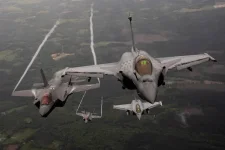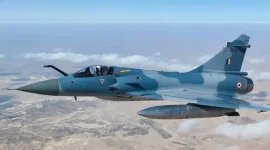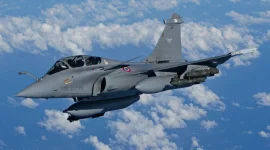- Views: 2K
- Replies: 7
The Dassault Rafale, a highly capable multirole fighter jet operated by several nations including India, is facing a critical challenge that could impact its combat readiness.
Concerns are growing among operators over the French manufacturer's prolonged timeline for essential technological upgrades, specifically the transition to advanced Gallium Nitride (GaN) based avionics, which is not expected to be complete until the early 2030s.
This delay threatens to leave the Indian Air Force (IAF) and other users at a strategic disadvantage against rapidly modernising adversaries.
At the heart of the issue is the Rafale's current Active Electronically Scanned Array (AESA) radar and its electronic warfare systems, which are built on Gallium Arsenide (GaAs) technology.
While effective, GaAs is being surpassed by the next generation of Gallium Nitride (GaN) systems. GaN-based radars offer significantly higher power efficiency, greater detection range, and superior resistance to electronic jamming.
This technological leap is considered vital for the Rafale to maintain its superiority against advanced threats such as China’s J-20 stealth fighter and sophisticated air defence systems like the S-400.
However, Dassault Aviation's roadmap indicates that a comprehensive GaN upgrade for the Rafale's radar and its SPECTRA electronic defence suite may not be fully realised until at least 2033. This slow pace is alarming for air forces that rely on the jet for a strategic edge.
The problem is compounded by Dassault's significant production backlog. The company is currently working through orders for over 200 Rafale jets for nations including India, Qatar, Egypt, and Indonesia.
With a strained production line reportedly manufacturing only one to two aircraft per month, resources for simultaneous research, development, and retrofitting of existing fleets are limited.
This bottleneck not only slows down the delivery of new aircraft but also delays the integration of critical enhancements into jets already in service.
For the Indian Air Force, which operates a fleet of 36 Rafales, the situation poses unique difficulties.
The IAF requires specific modifications tailored to its operational needs, including the integration of indigenous weapons like the Astra air-to-air missile and compatibility with India’s NavIC satellite navigation system.
The full implementation of these India-Specific Enhancements (ISE), part of the original 2016 agreement, has already faced delays.
Dassault’s centralised approach to upgrades, which often aligns with the requirements of the French Air and Space Force, offers less flexibility compared to competitors.
American manufacturers like Lockheed Martin and Boeing provide more modular and adaptable upgrade pathways for their F-35 and F-15EX aircraft, allowing customers greater control over modernisation schedules.
This dependency on a single manufacturer for major software and hardware enhancements leaves operators like the IAF vulnerable to timelines set by the original equipment manufacturer.
The operational implications of this delay are significant. The IAF, currently managing approximately 31 fighter squadrons against a sanctioned requirement of 42, cannot afford a prolonged wait to upgrade its most advanced platforms.
A delayed transition to GaN technology could diminish the Rafale's effectiveness in contested airspace, such as along the Line of Actual Control (LAC) with China, where enemy aircraft like the J-20 are being equipped with increasingly powerful sensors.
The delay also impacts the Rafale's ability to conduct crucial missions such as the Suppression of Enemy Air Defences (SEAD), potentially reducing its value as a strategic deterrent. Furthermore, extending the life of older GaAs components can lead to increased maintenance and life-cycle costs for operators.
This challenge highlights the importance of India's push for strategic autonomy in defence manufacturing. Frustration with foreign dependency has added urgency to indigenous projects like the Advanced Medium Combat Aircraft (AMCA), India's own fifth-generation fighter program. The first prototype of the AMCA is expected to fly by 2029, with induction planned for the mid-2030s.
As global military aviation advances, Dassault Aviation faces mounting pressure to accelerate its upgrade cycle and provide more flexible solutions.
For the Indian Air Force, the path forward involves pressing its international partners for timely support while decisively investing in its own domestic defence industry to secure its airspace for the future.



